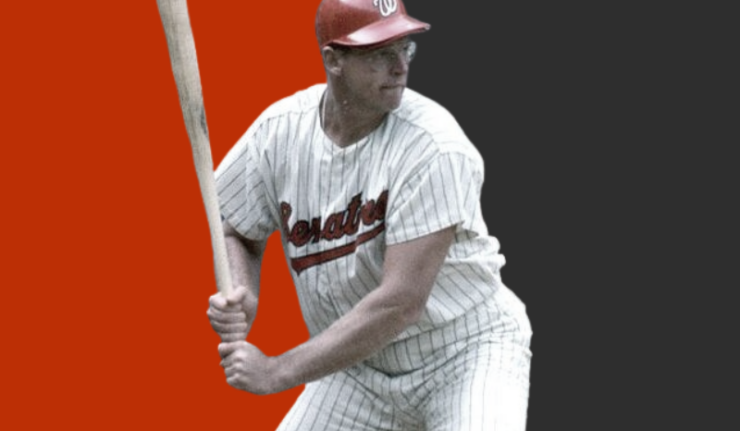On Halloween Eve, former All-Star outfielder Frank Howard died in Virginia at the age of 87.
Howard was a bizarre and awesome sight in his era: a 6-foot-inch, 260+ pound specimen who waved a bat like most people handle a toothpick. Howard was National League Rookie of the Year with the Dodgers in 1960, but he made his fame as the gigantic slugger for the Washington Senators. From 1968 to 1970, while most of the hitters in baseball were suffering through the Second Deadball Era, Big Frank averaged 45 home runs.
When Howard finally hung up his size-15 shoes after 16 seasons in 1973, he had 382 home runs to his credit. That figure stood among the 25 most in baseball history at the time. The man they called “The Capital Punisher” and “The Washington Monument” was a man ahead of his time. The things big, tall Aaron Judge does now: Frank was pretty much doing that more than five decades ago, an redefining what a tall, big man could do in a baseball uniform.
Lost in the shuffle with the Dodgers
The Dodgers farm system produced four promising outfielders who debuted between 1958 and 1960: Frank Howard, Ron Fairly, Willie Davis, and Tommy Davis. From this group the team expected to replace the aging Duke Snider and Carl Furillo and restock the outfield for the pennant battles of the 1960s. Fairly was slow but he could hit any type of pitching, he was sort of a Rusty Staub clone. Willie Davis was the fastest man in baseball, impatient and impetuous, an exciting outfielder. Tommy Davis was a very tough kid from Brooklyn, a free-swinging slugger who signed with the Dodgers after Jackie Robinson personally called him on the phone. The last man in the quartet was Howard, a behemoth who could hit a baseball high and far. Howard was an odd sight: he was 6’7, weighed 260 pounds, had size 16 feet, and he wore thick spectacles. A lot of people predicted Howard would break home run records.
You can’t play four men in the outfield, so the Dodgers switched Fairly to first base. They tried to make Tommy Davis a third baseman, without success. By 1962 the Davis Boys and Big Frank were in the outfield, Tommy in left, Willie in center, and Howard in right field. The next season the team won the World Series with all four players in the starting lineup (Fairly, Davis, Davis, and Howard). In that World Series in Yankee Stadium, Howard hit a ball off the monument in center field that bounced so hard it came back to Mickey Mantle quickly, and Big Frank had to hustle just to get a double.
But even as Howard was belting home runs, he kept getting jerked around by manager Walt Alston, who frequently platooned him. Prior to the 1964 season, Big Frank shocked the Dodgers when he told them he was retiring to “spend time with my growing family.” But Howard reversed that decision before spring camp and expressed his desire to play every day. But when he batted .226 in 1964 the Dodgers traded him. Los Angeles got Claude Osteen in exchange from the Senators, who pitched well for the team for a long time.
The Washington Monument
Howard was correct, he needed to be allowed to play regularly. In Washington he fulfilled his promise, averaging 34 homers per season from 1965 to 1971. From 1968 to 1970 he averaged 45 homers and 114 runs batted in, and he was an All-Star every season. He was a team leader and he played through nagging injuries. There was no one else in the Washington lineup as dangerous, so pitchers intentionally walked Howard a lot, but he still pounded the baseball at RFK Stadium. He hit home runs in bunches: one time he hit ten homers in a six-game stretch, and he belted 15 homers in one month. When he got on a roll, Howard was like something no one had ever seen.
How great was Howard? When Washington D.C. regained its baseball team in the 21st century, it made the decision to honor players from the former franchises in the district. In 2016, Howard was inducted into the Washington Nationals Ring of Honor, the first, and so far only player from the 1961-1971 Senators to be so honored.
First Home Run for the Texas Rangers
Only two days after Howard’s death, the Texas Rangers won their first World Series title. The man who smacked the very first homer in team history just missed out on seeing it. In 1972, under Texas manager Ted Williams, Howard hit a home run off Clyde Wright of the Angels at Arlington Stadium. He hit nine that year in the strange uniform of the Rangers before he was traded to Detroit for the stretch drive. He drove in seven in 14 games for the Tigers down the stretch, assisting them to a division title. Twelve more taters followed in 1973, in what ended up as his final MLB season. On September 8 in Boston, Frank belted a homer over the Green Monster at Fenway Park off lefthander Bill Lee for the 382nd and final homer of his career.
After a disappointing effort to play professionally in Japan in 1974, Howard returned to the U.S. and took a job managing for the Brewers in their farm system. For four seasons, he served on the coaching staff for the Brewers under Alex Grammas and George Bamberger. The Padres hired Howard to be their manager in 1981, but the talent-starved team finished in last place, and Frank was fired after one season.
Howard never lost his love of the game, and from 1976 to 2008, with the exception of one year, he was in uniform or on the payroll of a big league team. He had a brief stint managing the Mets in the 1980s, but that lasted just 116 games. His longest job was with the New York Yankees, where he spent five years as a coach, and nearly a decade as player development instructor, until he was 72 years old. In total, Howard spent more than five decades employed in professional baseball.
The Too-Tall Team
C: Joe Mauer, 6’5
1B: Tony Clark, 6’8
2B: D.J. LeMahieu, 6’4
SS: Cal Ripken Jr., 6’4
3B: Ryan Minor, 6’7
LF: Frank Howard, 6’7
CF: Aaron Judge, 6’7
RF: Dave Winfield, 6’6
DH: Dave Kingman, 6’6
SP: Randy Johnson, 6’10
SP: J.R. Richard, 6’8
SP: CC Sabathia, 6’6
SP: John Candelaria, 6’7
SP: Rick Sutcliffe, 6’7
RP: Jim Johnson, 6’6
RP: Dick Radatz, 6’6
MGR: Larry Dierker, 6’4
When Frank Howard was a 6-foot-2 inch 16-year old, he secured a job working for a road construction crew in Columbus, Ohio. “I worked all summer running a jackhammer for an asphalt gang,” Howard said. “I gained 40 pounds and put on five inches.”




